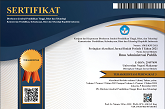Effect Of Government’s Policy to Build 1 Million Houses on Performance of Housing and Apartment Credits of Banks Listed in Indonesia Stock Exchange during Period 2015-2017
(1) Prodi Ilmu Manajemen SPs Universitas Pendidikan Indonesia
(*) Corresponding Author
DOI: https://doi.org/10.26858/jiap.v11i1.19777
Abstract
Through the Directorate General of Housing Financing, the Ministry of Public Works and Public Housing estimates that by 2025 the number of housing needs in Indonesia will reach 30 million units based on calculating housing needs (backlog) of population growth. In 2015, the Government Program's number of achievements for the Construction of One Million Houses was around 700 thousand units. In 2016, it reached 805,169 housing units, and in 2017 onwards, it is expected to reach the target of 1 million houses per year. The main problem in a housing development or the property sector is land availability and various communities' purchasing power. The government policy related to the construction of 1 million houses coupled with easy licensing of the land sector and provision of subsidies such as the liquid housing finance facility (FLPP) has stimulated the banking sector and other financial institutions to finance the property sector. The residential segment, namely apartments and housing, is the most significant contributor to the national property capitalization value, reaching 55.8%. The growth rate of the capitalization value of the residential sector reached 16.5%, from Rp. 152.7 trillion to Rp. 177.9 trillion in 2017. Focusing on KPR and KPA during the 2015-2017 period at banks listed on the Stock Exchange Indonesia.
Keywords
Full Text:
PDFReferences
Aisyah Oktasari Dian Pertiwi, Erman D. Arifianto. (2014). Loss Given Default (LGD) Kredit Pemilikan Rumah (KPR ) di Indonesia: Analisis Model Industri Perbankan dan Bank BTN Cabang Purwokerto Tahun 2002-2013: Jurnal Ekonomi Dan Kebijakan Publik Vol. 3. No. 3. ISSN (Online): 2337-3792
AusAID and the World Bank. (2016). Using In Indonesia: Expanding Access, Improving Efficiency. AusAID and the World Bank.
Badan Legislasi DPR-RI, (2015). Naskah Akademik Rancangan Undang-Undang Tabungan Perumahan Rakyat, DPR-RI, Jakarta.
CBRE Research. (2018). Real Estate Market Outlook. Asia Pacific
D.S, Bahril. (2016).Pembangunan Perumahan Rakyat Dalam Perspektif Mashlahah Studi Kasus : Perum Perumnas: Jurnal Analytica Islamica, Vol. 5, No. 2, 2016. Universitas Muhammadiyah Sumatera Utara Medan
Direktorat Jenderal Anggara. (2015). Peranan APBN dalam Mengatasi Backlog Perumahan Bagi Masyarakat Berpenghasilan Rendah (MBR). Jakarta: Kementerian Keuangan.
Dwianingrum, Titia. (2015). Determinasi Tingkat Penyaluran Kredit Pemilikan Rumah (Periode Setelah Kebijakan Loan To Value): Jurnal Jurusan Ilmu Ekonomi FEB UNBRAW.
Handoko, R dan Patriadi. P. 2005. Evaluasi Kebijakan Subsidi Non-BBM. Kajian Ekonomi dan Keuangan Volume 9 Nomor 4. http://www. litbang.deptan.go.id/studi-komprehensif-kebijakan-subsidi-pupuk-di-indonesia.pdf., diakses pada 08 April 2018
Iskandar, A. S., Ilham, I., & Jisal, M. (2019). Labor Productivity of the Silk Weaving Industry: A Case Study in Pakkanna Village, Wajo Regency. Jurnal Office, 5(2), 103-112.
Iskandar, A. S. (2018). Customer Relationship Management dan Pengaruhnya terhadap Loyalitas Nasabah pada Bank Rakyat Indonesia (BRI) Syariah Kantor Cabang Pembantu (KCP) Kota Palopo. Dinamis: Journal of Islamic Management and Bussiness, 1(1).
Iskandar, A. S., Tadjuddin, T., Lesti, L., & Rahmat, R. (2020). MOBILE BANKING SYSTEM. Kontigensi: Jurnal Ilmiah Manajemen, 8(2), 304-313.
Nur, I. M., & Iskandar, A. S. (2020). Murabahah Contract: Implementation on House Ownership Financing Products (KPR) at BNI Syariah Bank KC Palopo. Pinisi Business Administration Review, 2(2), 141-148.
Kusumastuti, Dora. (2015). Kajian Terhadap Kebijakan Pemerintah dalam Pemberian Subsidi di Sektor Perumahan. Jurnal: Yustisia Vol. 4. No. 3.
Lisnawati. (2015). Kebijakan Anggaran dan Skema Pembiayaan dalam Mengatasi Backlog Perumahan. Jakarta: Pusat Pengkajian Pengolahan Data dan Informasi14 (7).
Mangeswuri, Dewi Restu. (2016). Kebijakan Pembiayaan Perumahan Melalui Fasilitas Likuiditas Pembiayaan Perumahan (FLPP): Jurnal Ekonomi Dan Kebijakan Publik Vol. 7. No. 1.
Pakpahan, Deddy H. (2015). “The Three Musketeers’, Solusi Atasi Backlog Perumahan di Indonesia. Dalam http://jktproperty.com/three-musketeers-solusi-atasi-backlog-perumahan-di-indonesia/,
PWV. (2016). Real Estate 2020 Building The Future
Rini, PD. 2006. Analisis Pengaruh Pupuk Bersubsidi terhadap Kinerja Industri
Pupuk di Indonesia. Departemen Ilmu Ekonomi, Fakultas Ekonomi dan Manajemen, Institut Pertanian Bogor.
Smit, Marja C. Hoek- (2016). Technical Assistance For Policy Development For Enabling The Housing Market To Work In Indonesia. THE HOMI Project Team
Stigler, G.J. 1972. "The Theory of Economic Regulation." Bell Journal of Economics and Management Science 11: 3-21.
Article Metrics
Abstract view : 242 times | PDF view : 55 timesRefbacks
- There are currently no refbacks.
Copyright (c) 2021 Laely Purnamasari

This work is licensed under a Creative Commons Attribution 4.0 International License.
Diterbitkan oleh:
Program Studi Ilmu Administrasi Publik
Program Pascasarjana Universitas Negeri Makassar
JIAP Index By:

This work is licensed under a Creative Commons Attribution 4.0 International License.









